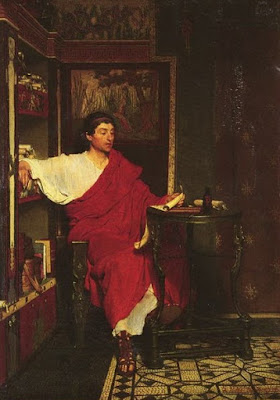“This time it will be quality pen and well-mixed ink and ivory-finished paper (charta etiam dentata), since you say you could hardly read my last letter” (Quint. fratr. 2.14)It is interesting that Cicero mentions that the paper is "ivory finished," that it was very white, or bright in appearance. This, of course, must have been more expensive papyrus than that which he normally used for writing letters. As Pliny the Elder wrote, there were various grades of papyrus manufactured (Nat. 74-82). Papyrus was not always available, either due to price or through scarcity. An early 2nd century letter from Terentianus to Tasoucharion reads, "I sent you papyrus so that you might be able to write me concerning your health" (P. Mich. VIII 481). Perhaps it was difficult for the recipients of the letter to obtain papyrus. Unwanted Bookrolls were often repurposed by turning them over and writing on the blank back surface. Martial mentioned that if his poems failed to please the critics boys would "scribble on the backs" of his epigrams (Epig. 4.86). One fragment of John's Gospel appears to be written on the back of a reused bookroll (See Larry Hurtado's description here).
In the New Testament, there is almost no reference to the type of writing material used by the authors. Therefore it is nearly impossible to know what materials upon which the authors wrote. In one instance, John mentions papyrus,
"Though I have much to write to you, I would rather not use paper and ink (διὰ χάρτου καὶ μέλανος). Instead I hope to come to you and talk face to face, so that our joy may be complete." (2 John 12. ESV)At least in this instance John likely used papyrus rather than a wooden or wax tablet, or any other material for that matter, in writing his epistles.
 |
| Alma Tadema's depiction of a Roman Scribe |

No comments:
Post a Comment